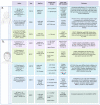Current Evidence for Biological Biomarkers and Mechanisms Underlying Acute to Chronic Pain Transition across the Pediatric Age Spectrum
- PMID: 37629218
- PMCID: PMC10455285
- DOI: 10.3390/jcm12165176
Current Evidence for Biological Biomarkers and Mechanisms Underlying Acute to Chronic Pain Transition across the Pediatric Age Spectrum
Abstract
Chronic pain is highly prevalent in the pediatric population. Many factors are involved in the transition from acute to chronic pain. Currently, there are conceptual models proposed, but they lack a mechanistically sound integrated theory considering the stages of child development. Objective biomarkers are critically needed for the diagnosis, risk stratification, and prognosis of the pathological stages of pain chronification. In this article, we summarize the current evidence on mechanisms and biomarkers of acute to chronic pain transitions in infants and children through the developmental lens. The goal is to identify gaps and outline future directions for basic and clinical research toward a developmentally informed theory of pain chronification in the pediatric population. At the outset, the importance of objective biomarkers for chronification of pain in children is outlined, followed by a summary of the current evidence on the mechanisms of acute to chronic pain transition in adults, in order to contrast with the developmental mechanisms of pain chronification in the pediatric population. Evidence is presented to show that chronic pain may have its origin from insults early in life, which prime the child for the development of chronic pain in later life. Furthermore, available genetic, epigenetic, psychophysical, electrophysiological, neuroimaging, neuroimmune, and sex mechanisms are described in infants and older children. In conclusion, future directions are discussed with a focus on research gaps, translational and clinical implications. Utilization of developmental mechanisms framework to inform clinical decision-making and strategies for prevention and management of acute to chronic pain transitions in children, is highlighted.
Keywords: EEG; QST; biomarkers; central sensitization; chronic pain; chronification of pain; developmental; genetics and epigenetics of pain; mechanisms; molecular markers; neuroimaging of pain; neurophysiological markers; pediatric pain; peripheral sensitization.
Conflict of interest statement
The authors declare no conflict of interest.
Figures


Similar articles
-
A Conceptual Model of Biopsychosocial Mechanisms of Transition from Acute to Chronic Postsurgical Pain in Children and Adolescents.J Pain Res. 2020 Nov 24;13:3071-3080. doi: 10.2147/JPR.S239320. eCollection 2020. J Pain Res. 2020. PMID: 33262642 Free PMC article. Review.
-
The Transition of Acute Postoperative Pain to Chronic Pain: An Integrative Overview of Research on Mechanisms.J Pain. 2017 Apr;18(4):359.e1-359.e38. doi: 10.1016/j.jpain.2016.11.004. Epub 2016 Nov 28. J Pain. 2017. PMID: 27908839 Review.
-
Predicting chronic postsurgical pain: current evidence and a novel program to develop predictive biomarker signatures.Pain. 2023 Sep 1;164(9):1912-1926. doi: 10.1097/j.pain.0000000000002938. Epub 2023 Jun 15. Pain. 2023. PMID: 37326643 Free PMC article. Review.
-
The Emotional Brain as a Predictor and Amplifier of Chronic Pain.J Dent Res. 2016 Jun;95(6):605-12. doi: 10.1177/0022034516638027. Epub 2016 Mar 10. J Dent Res. 2016. PMID: 26965423 Free PMC article. Review.
-
Pain chronification: what should a non-pain medicine specialist know?Curr Med Res Opin. 2018 Jul;34(7):1169-1178. doi: 10.1080/03007995.2018.1449738. Epub 2018 Apr 12. Curr Med Res Opin. 2018. PMID: 29513044
References
-
- Chidambaran V., Zhang X., Martin L., Ding L., Weirauch M., Geisler K., Stubbeman B., Sadhasivam S., Ji H. DNA methylation at the mu-1 opioid receptor gene (OPRM1) promoter predicts preoperative, acute, and chronic postsurgical pain after spine fusion. Pharmacogenom. Pers. Med. 2017;10:157–168. doi: 10.2147/pgpm.s132691. - DOI - PMC - PubMed
Grants and funding
LinkOut - more resources
Full Text Sources

